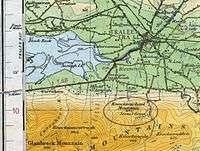Scotia's Grave
| Scotia's Grave | |
|---|---|
| Area | |
 Scotia's Grave Location in Ireland | |
| Coordinates: 52°13′34″N 9°42′38″W / 52.226151°N 9.710462°WCoordinates: 52°13′34″N 9°42′38″W / 52.226151°N 9.710462°W | |
| Country | Ireland |
| Province | Munster |
| County | County Kerry |
| Time zone | WET (UTC+0) |
| • Summer (DST) | IST (WEST) (UTC-1) |
| Irish Grid Reference | Q8309 |
Scotia's Grave or Scota's grave is an area just south of Tralee in County Kerry beside the Finglas rivulet in Trughanacmy. It marks what is reputed to be the grave of Scota, a daughter of an Egyptian Pharaoh known as Friel.[1] The traditional name of the location is Glenn Scoithin, 'vale of the little flower'. "Scoithin here may be a diminutive of Scota, and the 't' being aspirated, it may prove that the name 'Sgota' meant, as heretofor suggested, not 'Scythian woman', but was the Gaelic synonym for Rosa or Flora, usual names of women."[2]

According to several references in medieval Irish mythology, Scotia was the wife of the former Milesius and mother of six sons. She was killed in battle with the legendary Tuatha Dé Danann on the nearby Slieve Mish mountain. Scotia was said to have come to Ireland in 1700BC, [3]to avenge the death of her husband, the King who had been wounded in a previous ambush in south Kerry.
See also
References
- ↑ Maeve Here Lies: A Guide to Irish Graves Poolbeg, 1997 ISBN 1-85371-713-4 p. 156
- ↑ Keating, Geoffrey; John O'Mahony; Michael Doheny Foras feasa ar Eirinn do reir an athar seathrun ceiting, ollamh re diadhachta. The History of Ireland, from the Earliest Period to the English Invasion P.M. Haverty, New York, 1857 p.202
- ↑ Barrington T J; Discovering Kerry, Blackwater Press, Dublin, ISBN 0-905471-00-8, 1976